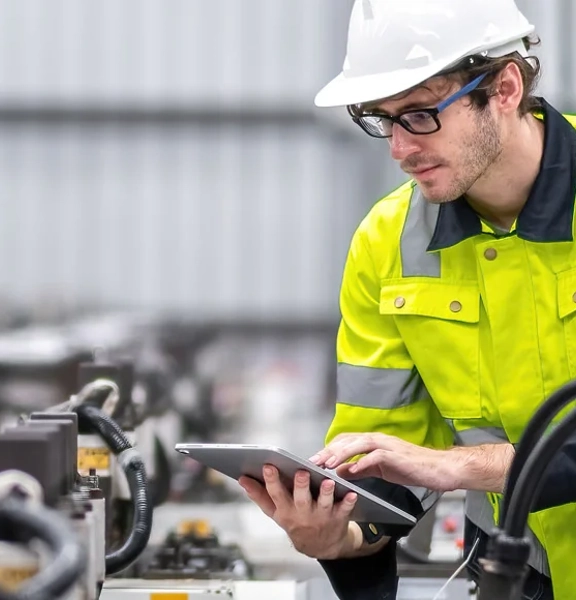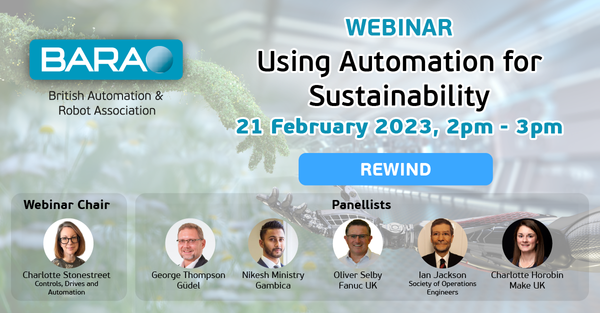Become a member
Take advantage of exclusive member benefits, world class events, networking and specialist support








 Become a member
Become a member 

This webinar hosted by BARA has been organised to examine the opportunities available to the automation and robot sectors in the UK to improve manufacturing process efficiencies, reduce waste, and aid sustainability.
The robot and automation industry has a key role to play in driving sustainability and helping us to achieve Net Zero.

The Opportunity
Net zero, despite the challenge, presents one of the single biggest opportunities for the automation and robot sector, as the industry is in a unique position to help the UK achieve its Net Zero ambitions.
In addition to improved sustainability and process efficiencies, Net Zero will open up new markets, enable new supply chain development, inspire self-sufficiency and NPD, and attract new workers to our industry.
Your company’s work over the coming decades will be key to developing technologies, designing, making the products, and providing the services that will help the rest of the economy decarbonise. BARA and the PPMA are excited to support our members on this journey.
In this webinar the opportunities that progression to Net Zero presents to our industry will be discussed by a panel of experts.
Discussion Topics
You can now watch the full video of the BARA Webinar below.

Charlotte Stonestreet is an experienced business and technology editor in the automation sector. In her current role, Charlotte heads up Controls, Drives & Automation magazine – a highly regarded publication providing insights for key decision makers, buyers and specifiers looking for products, solutions, technical and best practice advice in the areas of motion engineering, power transmission, automation, Industry 4.0 and digitisation.

George is an experienced account manager and sales engineer with a background in mechanical and industrial engineering, specialising in robotics and automation. George is also skilled in electrical wiring, troubleshooting and repair of electronic circuits, continuous improvement programmes and manufacturing engineering.

Responsible for representing the sector covering product groups such as Variable Speed Drives, Controlgear, Soft Starts. Nikesh has developed a wider understanding of both the technical and commercial areas of the manufacturing industry. Through his work for GAMBICA, and his previous work as a Technical Sales engineer and Account Manager within the industry.

With 20 years of experience in factory automation, Oliver Selby brings a wealth of industry and product knowledge to UK manufacturing and engineering. He is passionate about strategically transforming the UK’s automation and manufacturing position on the global stage and this can be seen through his customer first philosophy and drive to improve businesses efficiency and profitability using modern technology.

Ian Jackson has over forty years’ experience in electricity production, including power station plant operations, energy trading and economic regulation. The latter, involving the regulation of competition in generation and supply, renewable energy, decentralised generation and security of supply. Recently bringing his experience to the Society of Operations Engineer’s work on reducing emissions of carbon dioxide into the atmosphere resulting from operation of plant and equipment.

Charlotte’s role as Region Director is to engage Make UK’s members and assist them in advancing as a manufacturer by providing bespoke introductions, providing industry insight, attendance at events & networking, promoting their business and ensuring their views are heard; liaising with regional stakeholders and ensuring manufacturers’ interests are represented to LEPs.

"I agree it is not just about removing waste. Efficiency is securing the minimum amount necessary of both resources used and waste produced to achieve fully desired outcomes. Resources normally include, but are not limited to, time, energy, materials and finance. So, I would say “using automation to secure the minimum amount necessary of both resources used and waste produced to achieve fully desired outcomes”. I would add that any action won’t be sustainable unless it supports today’s society to achieve its needs and wishes in ways that least compromise future generations achieving their needs and wishes."
"The use of Industry 4.0 in this instance is more about connecting all aspects of the manufacturing process together so that the equipment can ‘communicate’ effectively. This will allow the like to balance itself when one section has too much product and/or if a section is being starved of product. In this type of situation, it is pointless running the automation at it’s maximum capability as the system as a whole cannot keep up, causing the excess use of electricity and or raw product. If the line runs to the weakest link in the chain, the system overall consumes less power, thus reducing waste. Then use the SixSigma type system to improve the weak link in the chain."

"Simulating the system prior to installation will help with multiple issues. Firstly, it will ensure that the automation is fit for purpose and is likely to hit cycle time. That being said, there may be differences between virtual and real installations.
Secondly, robot reach studies can be conducted to ensure the correct size of robot has been selected for the application.
Additionally, potential collision or obstructions can be resolved much easier and quicker in the virtual installation than if they are not caught until the physical installation.
Finally, there is the possibility of virtual commissioning where the virtual system can be interfaced with the PLC program (or actual PLC if one is available). This also has the potential to accelerate the on-site commissioning time as a direct result."

"I have not considered the UN Sustainability Goals. My point is that there are many interpretations of sustainability. The problem is that we talk and act on sustainability without being clear what we mean and why we wish to address the understanding we have. If you are making investment decisions founded on being more sustainable you need to be very clear what you understand as sustainable and why you want to be more of your understanding."

"Yes. Some of the Robot and PLC suppliers offer a remote monitoring service so that the early warnings can be detected and scheduled for maintenance instead of waiting for an unplanned stoppage, which causes wastage in the form of lost production or the loss of time sensitive raw product in either food or chemical manufacturing as examples."

"The opportunities and requirements for automation/robotics fall into two broad camps, they enable you to do things that you previously could not and they enable you to do some things more efficiently. Both camps provide the opportunities to broaden the practical scope and efficiency of the circular economy."
"There are several companies that specialise in taking ‘retired’ automation components and either stripping them for parts or refurbishing them for reuse in another application. Sometimes it is a good way to take the first step into automation, however in some examples you are buying problems. It is very similar to buying a used car. It may look nice on the surface but could not be so pristine on the inside. Every business has to make that decision for themselves."

"This is a bit like asking how long is a piece of string… It will depend on numerous factors, like what is the main drivers are for looking into automation. If it is simply headcount reduction, then the calculation is fairly easy. That being said, sometimes the same or more headcount will be required, but in different positions to keep up with the automation. The advantage of this is they are performing more ‘value added’ jobs instead of repetitive production tasks."

"Yes, that is the big risk. J.I.T. as with any system of work carries benefits and risks. We need to recognise the risks and benefits and drive to what we believe is the optimal balance. But also recognise that the optimal point for your business keeps moving and therefore you need to be always evaluating where your optimal point now sits."
"I agree with the above answer, however the risk with JIT is that any kink within the supply chain can bring a manufacturing facility to a grinding halt. Creating a buffer stock at the local manufacturing facility gives a little grace period for any potential glitches in the matrix."

"AI can be implemented into the scheduling solutions used by the manufacturers to learn and predict trends, however it would still need adequate information within the control data in order to learn these trends."

"Talk of carbon and carbon footprints is usually related to Climate Change and Global Warming. Carbon is not a greenhouse gas. Therefore, carbon has little to do with the amount of greenhouse gases in the atmosphere, the currently understood cause of Global Warming.
Carbon dioxide is a greenhouse gas. The amount of it in the atmosphere is understood to be currently higher than would occur naturally, leading to Global Warming. The extra carbon dioxide in the atmosphere is probably due to human actions both increasing the rate of carbon dioxide entering the atmosphere, through actions resulting in the burning of carbon, and reducing the rate of carbon dioxide leaving the atmosphere, through actions such as felling healthy trees.
Many of the promoted tools for measuring your “carbon footprint” appear to focus on fossil fuels, which are not greenhouse gases. The result is often to promote actions that result in increase emissions of carbon dioxide into the atmosphere. If we are to lower the amount of carbon dioxide in the atmosphere, we need to get all electricity and hydrogen production free of carbon dioxide emissions into the atmosphere. Until we reach that point, we need to focus on getting our processes and supply chains as energy efficient as possible, i.e. they are using the least amount of energy possible."

"Some degree of automation could be utilised by most production facilities, even those labelled as Cottage Industries. Automation doesn’t always need too be large complex systems, sometimes the right level of automation is a label application unit, case erector, case taping unit, case packer or perhaps a semi-automated pallet wrapper. Maybe it’s a combination of any number of these items. The more important thing is to implement the right level of automation for the current business needs, at the right time, with a future plan for growing the automation in line or just ahead of the business needs.
I have been involved in discussions with companies where they indicate that they produce one small batch of a product at a time and then change over to a different produce. Later in the conversation it will emerge those products are produced like that on a daily, weekly or monthly basis. This new piece of information changes the answer from ‘it’s not viable’ to ‘this will work’."

Similar answer to Q5 above.

"“Carbon neutral” and “Net Zero” are at best misleading terms. They both seem to help promote actions that result in higher concentrations of carbon dioxide in the atmosphere. There needs to be a radical shift of focus away from carbon and onto lowering the amount of carbon dioxide in the atmosphere. This means going from the current situation where more carbon dioxide is flowing into the atmosphere than is flowing out, to more carbon dioxide flowing out than is flowing in."

"Autonomous Robots – also known as AMR’s or AGV’s can be very flexible within a production environment as they can transfer items from one part of a facility to another by using what is referred to as ‘missions’. These missions are distributed to the AGV/AMR’s depending on a number of factors such as proximity to the origin point and remaining battery life. The efficiency of the missions will depend on how well the system is specified and implemented. One of the big advantages is the reduction in manual handling by operators, even if they are using carts (push / pull type injuries, etc). This is something that is not often factored into the payback of the AGV / AMR solution."

"Two to consider, cost and limitations of current technology."
"There is a common perception that automation is complex and also expensive, however this is all relative. Yes, there will be an initial investment required, but the benefits are often not visible on a spreadsheet. The Automation can also help to increase morale within the facility by helping to lighten the load in those operations that are Dull, Dirty or Dangerous.
Another barrier is courage. It can be a daunting prospect to start the Automation Journey. Do I need to reduce staff… How do I get started… I don’t know what to ask… These are all questions that I have heard from companies just starting out. There are several BARA Roundtables that will help answer these questions which are available at BARA events"

"This again raises the question of what do we mean by sustainable? Ignoring all other factors, it is hard to see how a local industry can remain competitive and thus financially sustainable if the components it is purchasing are above market prices."
"Yes and no. I am a firm believer in short supply chains as well as you get what you pay for. My Gran had a saying – ‘if you buy it cheap, you’ll buy it twice!”
Henry Ford was also once quoted as saying - “If you need a machine and don't buy it, then you will ultimately find that you have paid for it, but don't have it.”"

"My answer would be simply “YES”. Both need to be addressed and not just for environmental sustainability, but also for that of the business. Being a LEAN business doesn’t mean that you are scrimping, scraping or cutting corners. Small changes can have a huge difference! As an example, do you need a heavy cleaner / degreaser? There are several options that use a citrus based agent, which is a by-product of the juice industry – and it is just as good (if not better). Small change, huge environmental and commercial benefit… (and it smells better.)"

"Not just drives, but all actions. When making such comparisons compare how much energy is being used. For example, what powers the hydraulic device is it an electrically driven pump or a diesel engine driven pump? Then how much energy was used to make and deliver the electricity to the pump’s motor, compared with the fuel used to drive the diesel engine. In both cases don’t forget all the energy used to deliver the fuel to the power station/ diesel engine. For the power station, regardless of your supply contract, it is usually gas that was used to make your electricity, because all the available carbon dioxide emission free electricity generation was already running, including from the solar panels on your roof, before you started up the hydraulic device. When you put that extra demand on the system extra gas was burnt to produce your electricity.
It is through doing such detailed examination that it becomes clear that changing from a diesel engine car to an electric car will often result in an increase in carbon dioxide emissions. The carbon dioxide emissions from the diesel engine stop, but the carbon dioxide emissions from electricity generation increase by a greater amount."

"Again, it depends on what you define as sustainable. If the solid material is inert and not biodegradable then going into landfill, or better being used as material for flood defences from rising sea levels, looks to be a very sustainable route for redundant material from carbon dioxide emission free electricity generation. Most probably, the storage of redundant wind turbine material is more sustainable than storing nuclear waste from nuclear powered electricity generation, captured carbon dioxide from processes burning carbon and redundant material from electric batteries used to facilitate high usage of carbon dioxide emission free electricity generation.
A similar debate can be had over plastic that is inert and not biodegradable. Then looking forward, technology such as pyrolysis offers the opportunity to use waste plastic to produce hydrogen free of carbon dioxide emissions. The pyrolysis process could also help to reduce the need for electric batteries to facilitate high usage of carbon dioxide emission free electricity generation. This through the pyrolysis process operating at times of higher available electricity generation than demand. Then it could stop consuming power and the hydrogen it produced be used to generate more electricity when electricity demand would otherwise be higher than available electricity generation.
In summary, there are issues to address, but if we are focused on what the actual problem is then technological developments can move us to a more sustainable position. Using developments in automation will be one of the key components in driving sustainability."
"I know that there are a few organisations that are looking into ways of reusing the materials that are not currently recyclable, such as carbon fibre or fiberglass. I don’t think it will be long until that issue is resolved.
Solar panels have a similar issue as it’s not like recycling standard glass. Again, I do not think it will be long before all of these issues have a viable resolution."